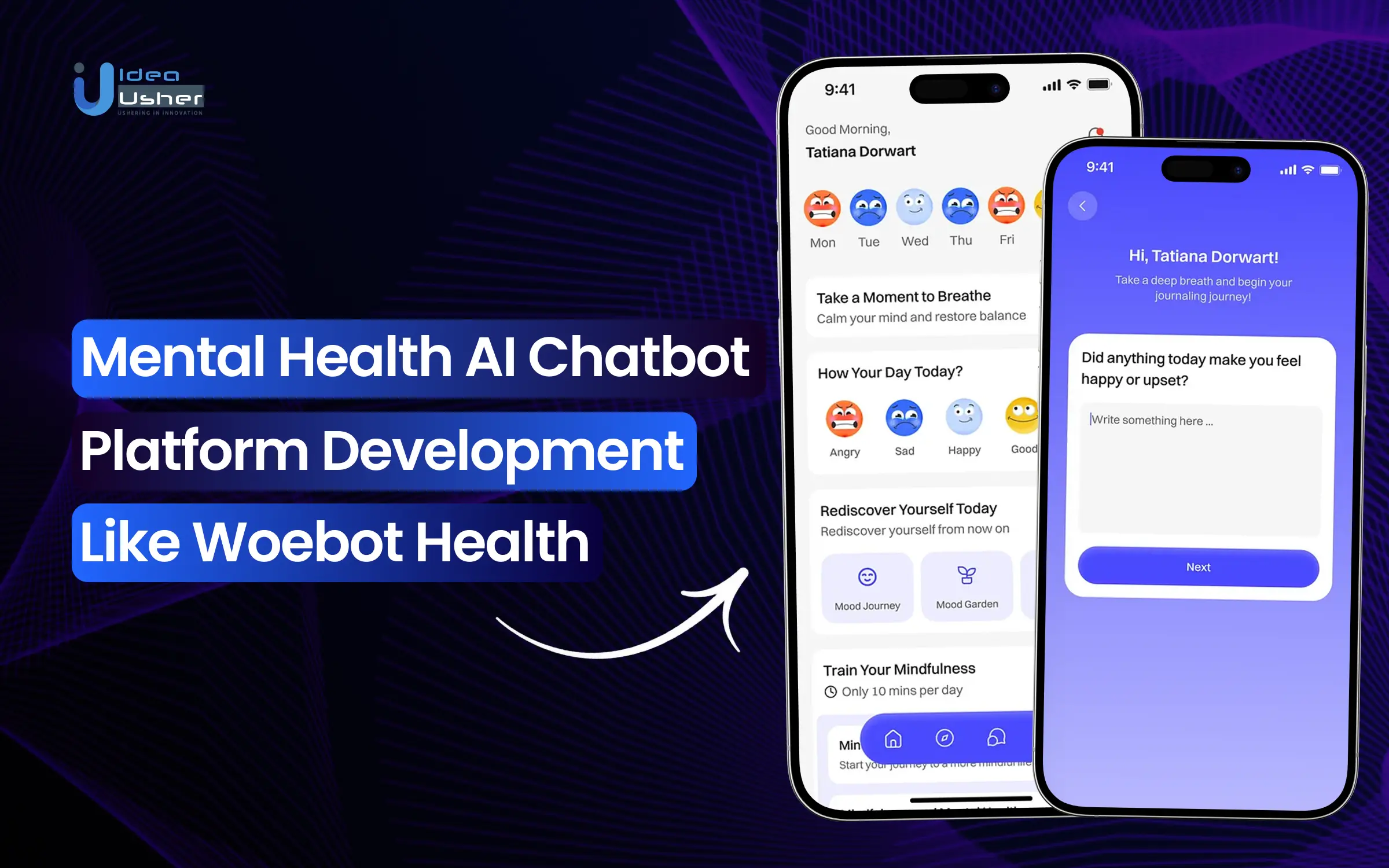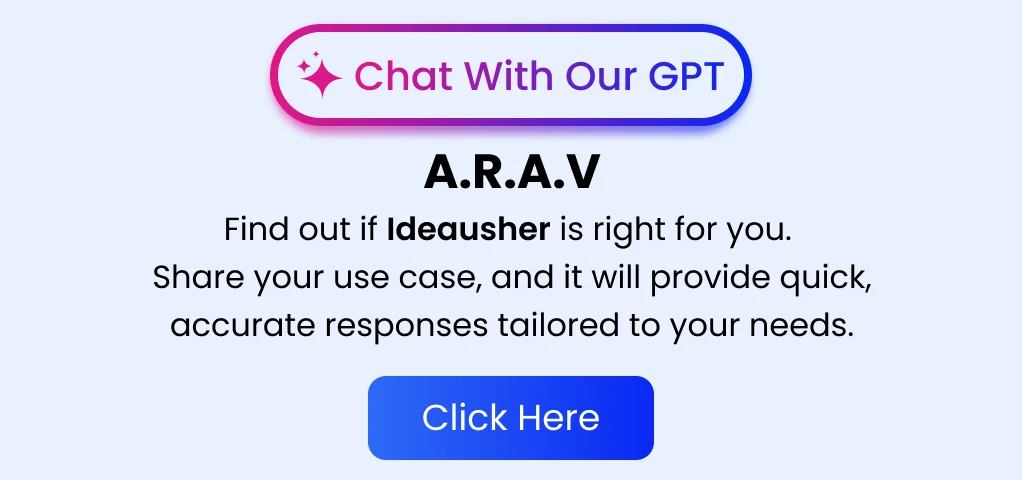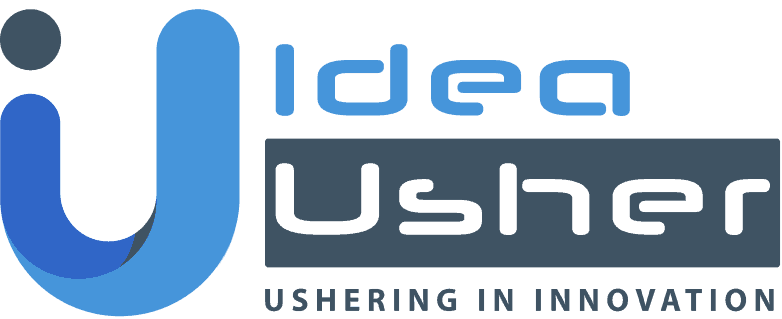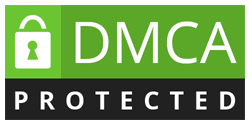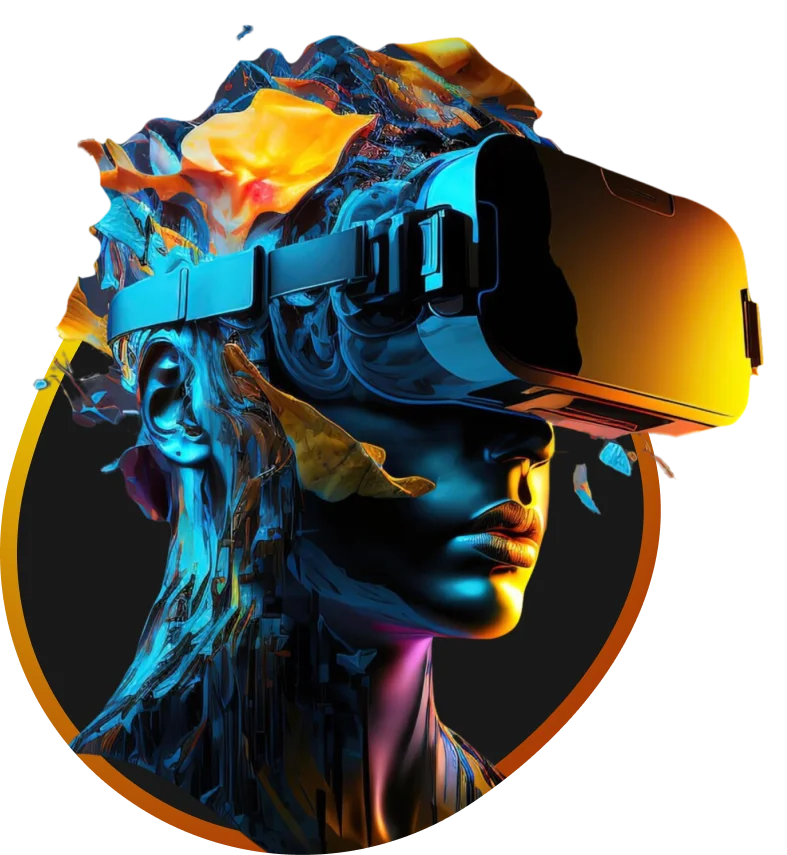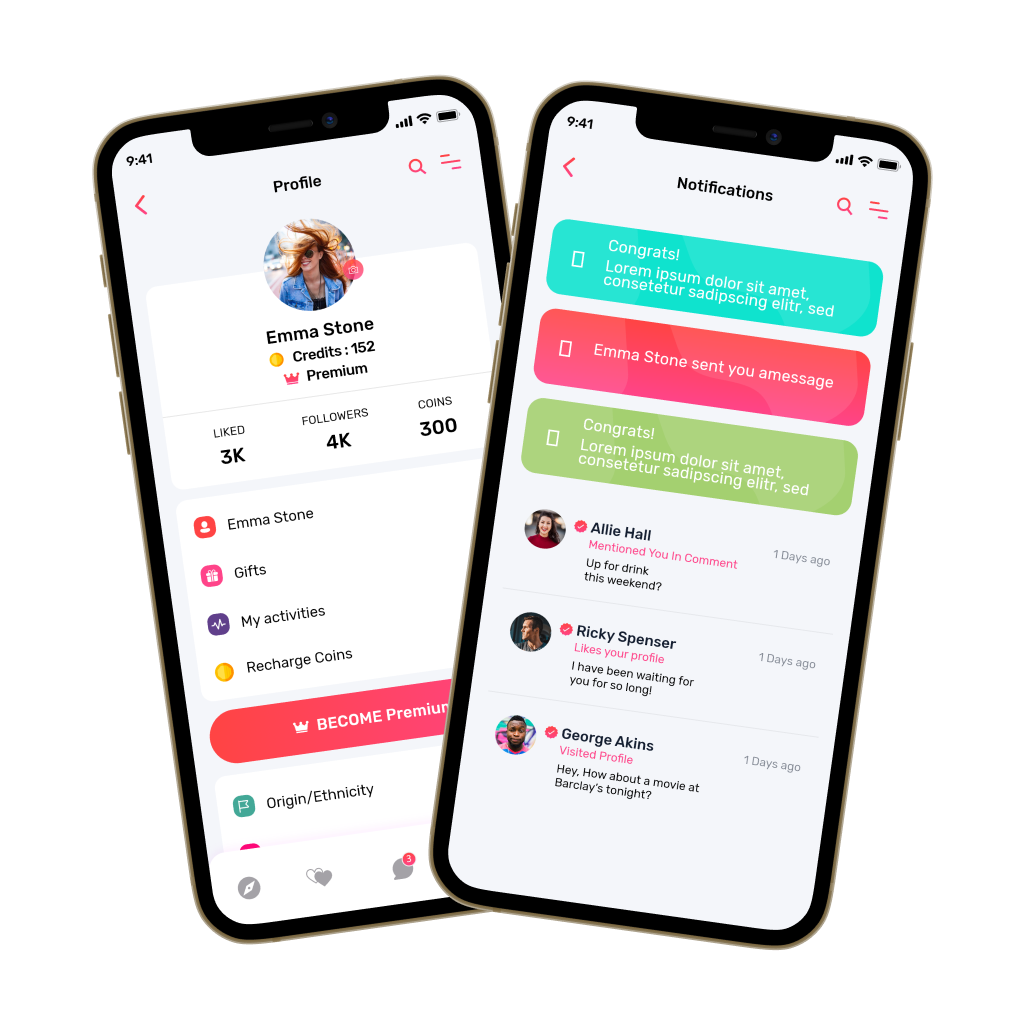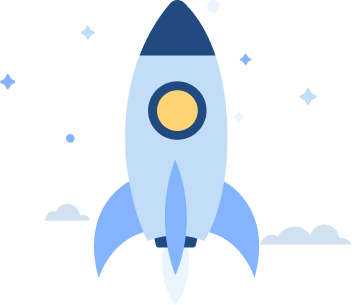Mental health challenges are increasingly common in today’s fast-paced world, yet many struggle to access support. While traditional therapy is effective, it can be costly and hard to schedule. AI mental health chatbots, like Woebot Health, provide personalized, evidence-based help enabled by continuous AI chatbot platform development, allowing individuals to cope with mental health issues in real time from any location.
AI-driven mental health platforms can make support more accessible and affordable, enabling timely help. The rising demand for mental wellness solutions makes an AI chatbot like Woebot a potential game-changer socially and commercially. This blog explores creating such a platform with practical steps, key considerations, and insights for entrepreneurs entering this growing market.
If you’re an entrepreneur looking to make a difference in the mental health space, this blog is for you. By following along, you’ll gain a clear understanding of how to develop an AI mental health chatbot, from the technical details to the ethical aspects, and learn how you can tap into a thriving industry while making a meaningful impact on people’s lives.
Key Market Takeaways Of AI Chatbot Platform
The global mental health AI chatbot market is projected to grow from $1.27 billion in 2024 to $1.38 billion in 2025, at a CAGR of 9.3%, and reach $1.95 billion by 2029, at a CAGR of 9.0%. This steady expansion highlights the increasing adoption of AI-driven mental health solutions.

For entrepreneurs looking to develop an AI mental health chatbot platform, this growth signals strong market demand and investment potential. The rising acceptance of digital mental health support presents a lucrative opportunity to build scalable and accessible solutions.
A prime example is Woebot Health, which has gained significant traction by providing AI-driven cognitive behavioral therapy (CBT) support. Its success underscores the potential for AI chatbots to revolutionize mental health care, making therapy more affordable and widely accessible.
What is Woebot Health AI Mental Health Chatbot Platform?
Woebot Health is an AI-powered mental health platform designed to provide accessible, evidence-based therapy and support. Utilizing Cognitive Behavioral Therapy (CBT) principles, it engages users through empathetic, real-time conversations to help them manage stress, anxiety, and depression. While not a replacement for clinical care, it serves as a valuable self-help tool, offering immediate emotional support.
Business Model of Woebot Health AI Mental Health Chatbot Platform
Woebot Health operates on a subscription-based model supplemented by enterprise partnerships and research collaborations.
- Subscription Revenue: Users pay for premium access to personalized therapy tools, gaining enhanced features and tailored mental health support. This ensures ongoing engagement and improved user outcomes.
- Enterprise Solutions: Companies integrate Woebot for employee mental wellness programs, promoting mental well-being in workplaces and reducing healthcare costs associated with stress-related issues.
- Research Collaborations: By partnering with academic institutions and healthcare firms to advance behavioral health, Woebot contributes to AI-driven mental health research and clinical validation.
- Consulting Services: Woebot assists healthcare providers in implementing AI-powered mental health solutions, leveraging its expertise to develop customized digital therapy experiences.
- Product Sales: Offering digital and physical self-help resources, such as guided journals, workbooks, and mental wellness courses, to complement its AI-driven support system.
How To Develop An AI Mental Health Chatbot Platform?
If you want to build a secure, effective, and user-friendly AI-powered mental health chatbot, you must follow some essential steps.
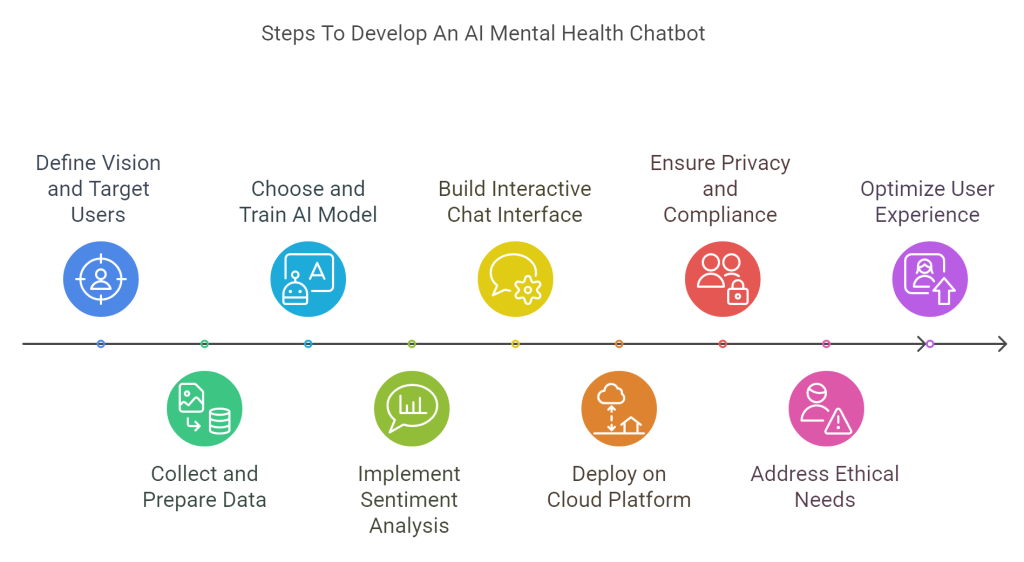
1. Define Your Vision and Target Users
Before starting development, it’s crucial to define the chatbot’s purpose and target audience. Determine whether it will support teens, professionals, or individuals facing specific mental health challenges. Identify key features such as mood tracking, guided meditation, coping strategies, and access to professional resources. A clear vision will help create a focused and impactful chatbot.
2. Collect and Prepare Data
AI-powered chatbots require high-quality training data to generate meaningful responses. Collect datasets from reputable sources, including clinical research papers, therapy transcripts, and synthetic conversations. Preprocess the data by removing noise, normalizing text, and structuring it for training. Ensuring data accuracy and diversity is essential for the chatbot’s effectiveness.
3. Choose and Train Your AI Model
Select an appropriate natural language processing (NLP) model, such as GPT, BERT, or a transformer-based architecture. Fine-tune the model with mental health-specific datasets to ensure that it understands user queries and provides appropriate responses. Incorporate reinforcement learning techniques to improve interactions continuously based on user feedback.
4. Implement Sentiment and Emotion Analysis
Integrate sentiment analysis to detect users’ emotions and adjust chatbot responses accordingly. AI algorithms should analyze text input to identify mood patterns, stress levels, and emotional shifts. This feature enables the chatbot to provide personalized and empathetic support, making interactions more meaningful for users seeking help.
5. Build an Interactive Chat Interface
Develop an intuitive and engaging chat interface where users can interact comfortably. Choose platforms such as mobile apps, web-based interfaces, or messaging services like WhatsApp, Facebook Messenger, or Telegram. Ensure the chatbot supports real-time conversations and is easy to navigate, enhancing user engagement and retention.
6. Deploy on a Scalable Cloud Platform
Select a reliable cloud provider such as AWS, Google Cloud, or Microsoft Azure to deploy the chatbot. Cloud-based deployment ensures high availability, scalability, and efficient performance monitoring. Continuously track user interactions and system performance to make real-time improvements and maintain a seamless user experience.
7. Ensure Privacy, Security, and Compliance
Mental health chatbots handle sensitive user data, making security and privacy a top priority. Implement end-to-end encryption, secure authentication mechanisms, and comply with regulations like HIPAA (for healthcare data) or GDPR (for user data protection). Users should be clearly informed about data usage policies and provided with options for data control.
8. Address Ethical and Crisis Support Needs
Develop protocols to handle crisis situations, such as users experiencing suicidal thoughts or severe distress. The chatbot should recognize high-risk conversations and provide emergency resources, such as helpline numbers or professional intervention services. Additionally, ensure that AI responses remain unbiased and inclusive to cater to diverse user needs.
9. Optimize User Experience and Personalization
A well-designed chatbot should feel natural and engaging. Implement AI-driven personalization to adapt responses based on the user’s emotional state, conversation history, and preferences. Provide options for different conversation tones, response styles, and interaction frequencies to create a more comfortable experience for each user.
How Much Does It Cost to Make an AI Mental Health Chatbot Platform?
The cost of developing an AI mental health chatbot platform depends on factors such as technology, features, security, and compliance. Below is a cost breakdown covering essential development steps.
| Development Step | Task | Description | Estimated Cost |
| Planning & Research | Market Research & Strategy | Identify user needs, competitors, and compliance requirements. | $2,000 – $8,000 |
| Data Collection | Gather & Preprocess Data | Collect mental health conversations and clean the dataset. | $3,000 – $12,000 |
| AI Model Development | Train NLP & Sentiment Analysis | Fine-tune models like GPT/BERT for mental health conversations. | $10,000 – $30,000 |
| Chatbot Development | Backend & Frontend Development | Build chatbot logic, API integration, and UI/UX design. | $8,000 – $25,000 |
| Security & Compliance | Data Encryption & HIPAA/GDPR Compliance | Implement privacy protocols and ensure data security. | $5,000 – $15,000 |
| Testing & Refinement | QA Testing & Bug Fixes | Conduct performance testing, AI response accuracy, and bug fixes. | $3,000 – $10,000 |
| Deployment & Cloud Hosting | Cloud Setup & Server Costs | Deploy on AWS, Google Cloud, or Azure for scalability. | $5,000 – $12,000 |
| Marketing & Launch | Branding & User Acquisition | Promote the chatbot, acquire initial users, and run campaigns. | $4,000 – $15,000 |
| Maintenance & Updates | Ongoing Improvements | Regular updates, user feedback integration, and AI model enhancement. | $5,000 – $15,000 |
Total Estimated Budget: $10,000 – $100,000
What to Keep in Mind Before Developing the AI Mental Health Chatbot Platform?
Developing an AI mental health chatbot requires careful planning, technical precision, and ethical considerations to ensure a safe, effective, and user-friendly platform. Here are the key aspects to focus on:
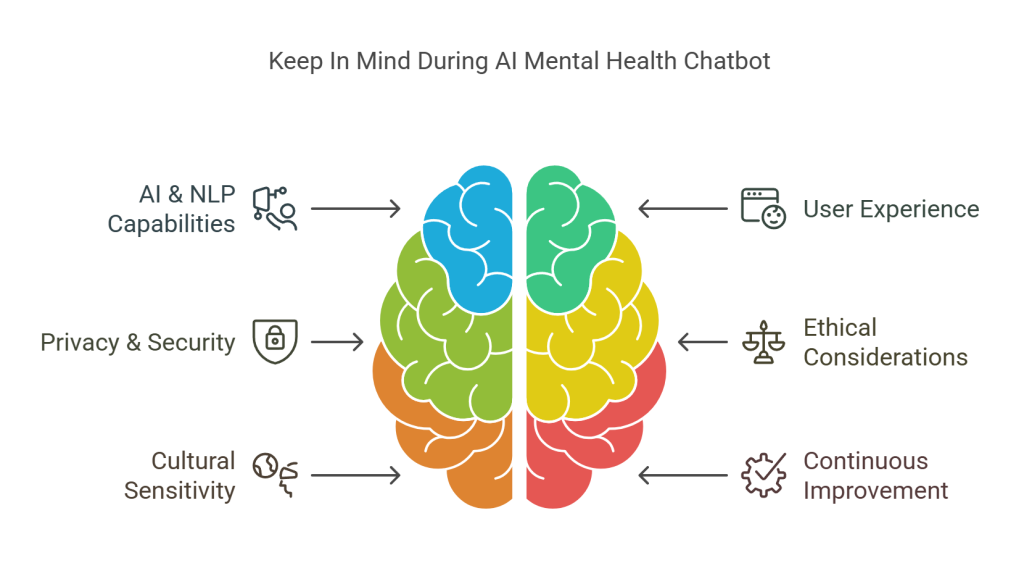
1. Strong AI & NLP Capabilities
The essence of any AI mental health chatbot lies in its ability to process human language effectively. Advanced NLP models like GPT or BERT enable the chatbot to understand user inputs, detect emotions, and provide meaningful responses. Incorporating sentiment analysis helps assess users’ emotional states, ensuring the chatbot offers empathetic support and tailored guidance. For better engagement, the chatbot should retain conversational context, remembering past interactions to create a supportive, human-like experience over time.
2. User Experience & Engagement
A well-designed user experience (UX) greatly influences user interaction with the chatbot. The platform must feature an intuitive interface for accessibility on mobile and web. Personalization, with customized responses based on user preferences and emotions, boosts engagement and encourages return visits. The chatbot should also include interactive elements like mood tracking, goal setting, and guided exercises to promote mental well-being effectively.
3. Privacy, Security & Compliance
Mental health discussions require strict data privacy and security measures. The chatbot must use end-to-end encryption to safeguard user data, adhering to regulations like HIPAA and GDPR. Users should provide informed consent before understanding the platform’s functions and data policies. Anonymous interactions can further enhance privacy, making individuals feel secure when seeking mental health support.
4. Ethical Considerations & Bias Mitigation
To create an inclusive AI chatbot, developers must eliminate bias in training data by using diverse datasets. Neglecting this can lead to inaccurate responses that harm users. The chatbot should also have protocols to identify distressed users and provide immediate resources or professional help. Ethical practices, including transparency in AI decision-making and ongoing human oversight, are crucial for maintaining trust and credibility.
5. Cultural Sensitivity & Inclusivity
Cultural variations in mental health require the chatbot to be sensitive in interactions. The AI must recognize how individuals express distress, ensuring inclusivity and respect for diverse backgrounds and beliefs. Regular updates and machine learning improvements based on user feedback are essential for enhancing the chatbot’s effectiveness globally.
6. Continuous Learning & Improvement
AI chatbots must evolve to improve accuracy and relevance. Implementing feedback mechanisms lets users provide insights on responses, helping developers refine interactions. Regular monitoring and evaluation are necessary to detect issues, enhance accuracy, and update the chatbot with advancements in mental health research. Keeping content current with psychological insights ensures the chatbot remains a reliable support tool.
Conclusion
Developing an AI mental health chatbot platform like Woebot Health presents a unique and impactful opportunity to address the growing need for accessible mental health support. By combining cutting-edge technology with compassionate care, you can create a service that not only improves lives but also taps into a thriving and expanding market. This article has outlined the essential steps, considerations, and strategies you need to get started, from understanding the technical aspects to ensuring ethical and privacy standards are met.
This blog offers a detailed guide for entrepreneurs entering the AI mental health sector. Discover how to choose AI tools, enhance user experience, and address privacy and ethics. With this knowledge, you can successfully launch and grow your AI chatbot platform, making a meaningful impact while seizing opportunities in a burgeoning industry.
Looking to Develop an AI Mental Health Chatbot Platform?
Take your mental health innovation to the next level with Idea Usher! With over 500,000 hours of coding expertise, we’re leaders in developing cutting-edge AI solutions tailored specifically for the mental health industry. Our advanced AI systems help organizations provide personalized therapy, enhance user engagement, detect emotional distress, and offer real-time support like never before. From sentiment analysis to real-time decision-making tools, we empower mental health platforms to leverage data-driven insights and improve outcomes for individuals seeking help. Partner with Idea Usher to unlock the full potential of AI in mental health and redefine how care is delivered, accessed, and experienced.
Work with Ex-MAANG developers to build next-gen apps schedule your consultation now
FAQs
Q.1. What is an AI mental health chatbot?
An AI mental health chatbot is a digital tool designed to provide immediate support for mental health issues through conversational interactions. Utilizing natural language processing (NLP) and artificial intelligence (AI), these chatbots can engage users in discussions about their feelings, offer coping strategies, and guide them through therapeutic techniques like Cognitive Behavioral Therapy (CBT). They serve as accessible resources for individuals seeking help, especially when traditional therapy options are unavailable.
Q.2. How do AI chatbots ensure user privacy and data security?
AI mental health chatbots prioritize user privacy by implementing strong data protection measures, such as end-to-end encryption and compliance with privacy regulations. Users are informed about data collection practices and must provide consent before engaging with the chatbot. These platforms must maintain confidentiality to build trust and safeguard sensitive personal information.
Q.3. Can AI chatbots fully address mental health needs?
AI chatbots are designed to provide immediate support and resources for various mental health concerns, but they cannot fully address all mental health needs. While they can offer coping strategies and basic guidance, they lack the depth of understanding and personalized care that a trained human therapist can provide. Chatbots are best utilized as a first step in mental health care, helping users manage their emotions and encouraging them to seek professional help when more comprehensive support is required.
Q.4. What types of mental health issues can AI chatbots address?
AI mental health chatbots can assist with a variety of issues, including anxiety, depression, stress management, loneliness, and more. They provide coping strategies, mindfulness exercises, and self-assessment tools to help users manage their mental well-being. However, for severe conditions or crises, it is essential to consult trained mental health professionals for appropriate care.
